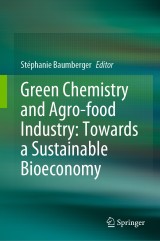Details

Green Chemistry and Agro-food Industry: Towards a Sustainable Bioeconomy
|
223,63 € |
|
| Verlag: | Springer |
| Format: | |
| Veröffentl.: | 22.04.2024 |
| ISBN/EAN: | 9783031541889 |
| Sprache: | englisch |
Dieses eBook enthält ein Wasserzeichen.
Beschreibungen
<p>The objective of the book is to show the complementarity and integration of food and non-food value chains for the development of a sustainable bioeconomy. One current challenge facing industry and the economy is to meet the needs of a growing world population while preserving the environment. The use of fossil energy resources for several decades has generated a decrease in reserves of these resources, together with a phenomenon of global warming due to the release of greenhouse gases into the atmosphere. More and more industrial sectors, including the chemical industry, are replacing fossil carbon with renewable carbon. The bioeconomy consists in using renewable biological resources to produce food, materials, and energy. A bioeconomy based on the green chemistry and biotechnologies is developing worldwide, as a lever for reducing the ecological footprint of human activities. The book is articulated around six parts, each dedicated to a keystone of the interface betweengreen chemistry and Agro-Food Industry.<br></p>
<p><b>Part 1 - From green chemistry to biotechnologies.- </b><b>Chapter 1.</b> Green chemistry, eco-friendly chemistry, biorefinery.- <b>Chapter 2.</b> Industrial biotechnologies: a hub at the crossroads of the food industry and green chemistry.- <b>Part 2 - Agricultural resources and co-products: sources of polymers, fuels and molecules for chemistry.- </b><b>Chapter 3.</b> Edible oils and oleochemistry.- <b>Chapter 4.</b> Anaerobic digestion: application to the energy recovery of agricultural co-products and food industry waste.- <b>Chapter 5.</b> Production of biofuels from agricultural resources.- <b>Chapter 6.</b> Potential of microalgae.- <b>Chapter 7.</b> Residues from the food industry: an under-exploited global source of biomolecules of interest.- <b>Chapter 8.</b> Obtaining aroma from by-products and effluents of the food industry.- <b>Part 3 - Green chemistry and polymer materials: towards new food packaging.- </b><b>Chapter 9.</b> Innovation in polymer science – what to expect from green chemistry.- <b>Chapter 10.</b> Converting agro-industrial by-products into biodegradable composite materials for food packaging: presentation of an eco-reasoned approach.</p>
<p>Stéphanie Baumberger is Professor in Green chemistry at AgroParisTech Paris Institute of Technology for Life, Food and Environmental Sciences, which is a part of the Paris-Saclay University. She is Leader of a research team dedicated to lignocellulosic biopolymers at the Institut Jean-Pierre Bourgin (UMR 1318 Université Paris-Saclay, INRAE, AgroParisTech) in Versailles (France). With an initial background in food science, she progressively orientated her activities towards the non-food uses of agro-resources, then biorefinery and bioeconomy systems. She has a 30-year expertise in the investigation of lignin structure and functionalities. After a Ph.D. thesis on starch-lignin composites defended in 1997, she has coordinated several projects related to lignocellulose biorefineries, among which the European project Zelcor (zero-waste lignocellulosic biorefineries) that earned her the prize “Les étoiles de l’Europe” in 2021. She has built-up and coordinates a European master in Biological and chemical engineering for a sustainable bioeconomy (Bioceb) which benefits from the support of the European Union in the framework of the Erasmus Mundus programme. She is Co-author of 60 scientific papers in international journals, 5 book chapters, 90 communications, and 1 patent, and Coordinator of a book. She trains each year master’s and Ph.D. students from 20 different nationalities and benefits from collaborations in 17 countries all over the world.</p>
The objective of the book is to show the complementarity and integration of food and non-food value chains for the development of a sustainable bioeconomy. One current challenge facing industry and the economy is to meet the needs of a growing world population while preserving the environment. The use of fossil energy resources for several decades has generated a decrease in reserves of these resources, together with a phenomenon of global warming due to the release of greenhouse gases into the atmosphere. More and more industrial sectors, including the chemical industry, are replacing fossil carbon with renewable carbon. The bioeconomy consists in using renewable biological resources to produce food, materials, and energy. A bioeconomy based on the green chemistry and biotechnologies is developing worldwide, as a lever for reducing the ecological footprint of human activities. The book is articulated around six parts, each dedicated to a keystone of the interface between green chemistry and Agro-Food Industry.
Presents kaleidoscope of visions on the Bioeconomy Provides up-to-date focus on innovations Showcases numerous definitions of terms and concepts
Diese Produkte könnten Sie auch interessieren:

The Neural Crest and Neural Crest Cells in Vertebrate Development and Evolution

von: Brian K. Hall

149,79 €















